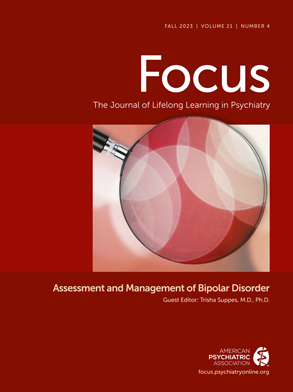In this edition of Focus, I have selected topics that at first glance might be afield of the usual topics on patients with bipolar disorder. We are not discussing the newest treatments for mania or depression, of which there are a couple of notable ones. Instead, a range of topics central to our thinking and the evolving field of bipolar disorder are presented. The authors themselves are each key figures and are doing work that adds to our understanding of best practices, such as Izadi et al.’s article, “Suicide Assessment and Prevention in Bipolar Disorder: How Current Evidence Can Inform Clinical Practice.” The articles also expand our knowledge about central features of bipolar disorder, such as in Nicoloro-SantaBarbara and colleagues’ “Cognition in Bipolar Disorder: An Update for Clinicians,” and the exciting work ongoing in older-age bipolar disorder, as highlighted in Dols et al.’s article, “Bipolar Disorder Among Older Adults: Newer Evidence to Guide Clinical Practice.” Not to neglect core considerations for clinical practice and consideration, an overview of one of the most thorough recent treatment guidelines is presented in Keramatian and colleagues’ review, “The CANMAT and ISBD Guidelines for the Treatment of Bipolar Disorder: Summary and a 2023 Update of Evidence.” Finally, an often-neglected patient group both for treatment studies and even recognition, that of patients with bipolar II disorder is reviewed in “Bipolar II Disorder: Understudied and Underdiagnosed,” by Swartz and Suppes.
There was a decline in clinical research on bipolar disorder for several years due to the National Institute of Mental Health policy to move away from clinical trials, and as well a few years of limited new pharmaceutical products. However, the field was not silent; during this time, the interest and passion of clinicians and researchers in the field pushed for more understanding, new treatments, and improved management of patients with bipolar disorder. With new resources coming into the field of study of bipolar disorder, including substantial philanthropic funds, there is excitement and energy about future treatment and improving the lives of patients with bipolar disorder.
Recently, I attended the first in-person meeting since 2019 of the International Society for Bipolar Disorders (ISBD) in Chicago. There was such an air of excitement, and not only for the researchers from different parts of the world who hadn’t seen one another in years. This meeting is also unique in that experts by experience are integrally woven throughout the meeting with sessions and breakout groups. In our work, awareness of the recipients, experts by experience, is always in our consideration.
At this meeting, it was clear that we are building on the large body of work to date and that there are many new and rich studies on the way. Just as the field of psychiatry is excited about the possibility of rapid-acting therapies, potential new treatment options were presented at the ISBD annual meeting, including a small pilot of chronically depressed patients with bipolar II disorder who showed a potential response to one-time dosing with psilocybin, new stimulation approaches for depression in bipolar disorder, potential new and useful biomarkers, and many more. The field of bipolar disorder is thriving, a new generation of researchers is developing, and we can expect many new findings in the future that improve our understanding and best practices.

